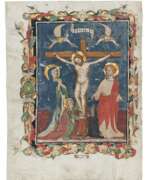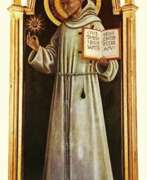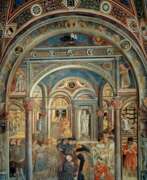Miniaturists Gothic art


Pol de Limburg, also Paul van Lymborch or van Limburg, was an early 15th-century French miniaturist from the Northern Netherlands.
Together with his two brothers, Herman and Jean, Pol worked in Paris. As teenagers, all three entered the service of Jean de France, Duc de Berry. It was for him that two of the most lavishly illustrated books of hours (a popular form of private prayer book at the time) were created.
Pol evidently had the greatest skill among the brothers and to him belongs the bulk of the work. After the completion of the Red Gazetteers, the brothers set to work on the Duke de Berry's Three Rich Gazetteers. This work, considered their greatest creation, belongs among the finest examples of the International Gothic style.
The Limburg brothers left The Rich Days of the Duke de Berry unfinished, as they died almost simultaneously in 1416, possibly during a plague epidemic.
The Limbourg brothers are the best known of all late Gothic manuscript illuminators. Together they synthesized the innovations of other illuminators and developed a style of their own, characterized by fine lines, painstaking technique, and minute detail. Their "Rich Days of the Duc de Berry," completed about 1485 by Jean Collomb, is one of the milestones in the art of book illumination. It greatly influenced the course of early book illumination and foreshadowed the paths of Northern Renaissance art.


Jacopo di Paolo was an Italian painter and illuminator who worked in Bologna during the fourth and fifth centuries.
Jacopo was a very versatile artist, working in several of the city's famous decorative studios and collaborating with sculptors to create drawings for sculptures. He was also involved at various levels in the political and cultural life of the city. Jacopo was enrolled in the Guild of Artists and Jewelers and held many public positions in Bologna. Jacopo's influence in Bologna lasted for half a century and his three sons also became artists.


Bernat Martorell, a Catalan painter, was a pivotal figure in the International Gothic style in Catalonia. His works, primarily religious in theme, are revered for their vivid portrayal of drama and violence, often featuring the martyrdom of saints like Saint Eulalia, Saint Lucy, and Saint Catherine. Martorell's unique style, influenced by contemporary Flemish painting, brought a new level of detail and color richness to Catalan art.
Among his notable works are the Saint George Killing the Dragon, housed at the Art Institute of Chicago, and the Retable of Saint Pere de Púbol, displayed in the Museu d'Art de Girona. These pieces exemplify Martorell's mastery in composition and his pioneering role in Catalonian art. His altarpieces, including those of Saint Vincent and Saint Lucy, further showcase his exceptional talent and influence on the Catalan art scene.
For collectors and experts in art and antiques, Martorell's legacy in the realm of medieval art is unquestionable. His works are a testament to the rich cultural history of Catalonia. To stay updated on new product sales and auction events related to Bernat Martorell, sign up for our updates. This subscription is your gateway to exploring the intricate beauty of Martorell's art and its impact on the world of painting and sculpture.























